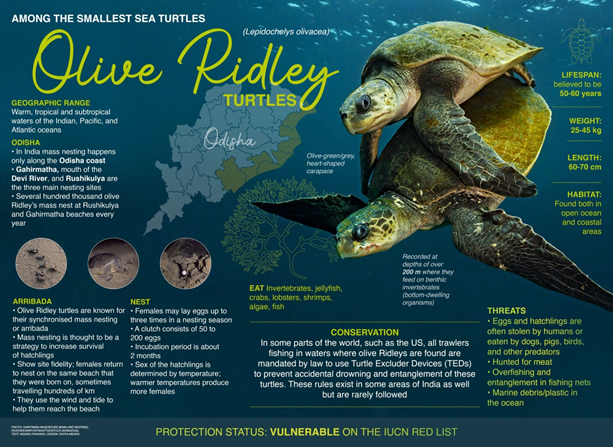

29th March 2022 (6 Topics)
Context
Despite concerns over erosion in coastal areas due to high tide, this year marked a record mass nesting of endangered Olive Ridley turtles at Rushikulya beach.
About
About Olive Ridley Turtles:
- They are the smallest and most abundant of all sea turtles found in the world.
- Major nesting sites in India:Rushikulya rookery coast (Odisha), Gahirmatha beach (Bhitarkanika National park) and mouth of the Debi River.
- Scientific name: Lepidochelys olivacea; also known as the Pacific ridley sea turtle.
- Presence:Found in warm waters of the Pacific, Atlantic and Indian oceans.
- Conservation Status:
- IUCN Red List: Vulnerable
- Schedule I of Indian Wildlife (Protection) Act, 1972
- CITES Appendix I
- Features:
- Known for their unique mass nesting called Arribada, where thousands of females come together on the same beach to lay eggs.
- These are carnivores and feed mainly on jellyfish, shrimp
- The eggs hatch in 45 to 60 days, depending on the temperature of the sand and atmosphere during the incubation period.

About Rushikulya rookery:
- The Ruskikulya Rookery is located in Odisha.
- The rookery is situated on the Rushikulya Beach in Ganjam district.
- The coast of Odisha is the largest mass nesting site for these sea turtles.
- It is at the mouth of river Rushikulya.
- The Rushikulya River is one of the major rivers in the state of Odisha.
- The Rushikulya originates at an elevation of about 1000 metres from Daringbadi hills of the Eastern Ghats range.
- It meets the Bay of Bengal at Puruna Bandha in Ganjam.
- Its tributaries are the Baghua, the Dhanei, the Badanadi etc.
- It has no delta as such at its mouth.



